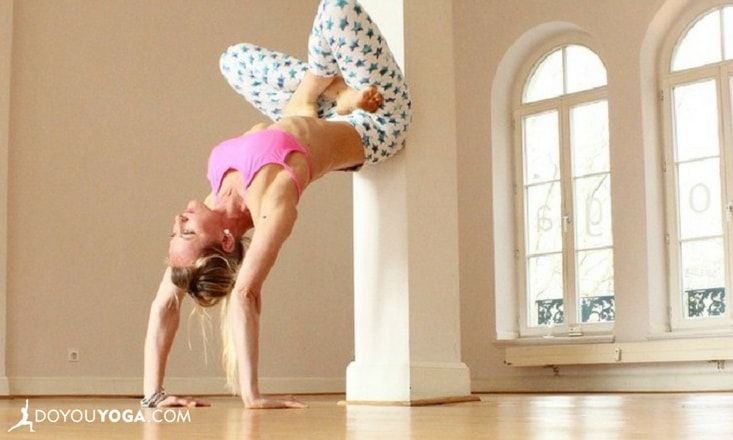Backbends can have profound effects on managing acute and chronic anxiety. They require the body to expand and open the heart up to new possibilities, thereby letting go of the anxiety. However, anyone who has practiced standing drop backs to Urdhva Dhanurasana (Wheel Pose) can attest that the practice of backbending can also create feelings of anxiety and nervousness.
While yoga teaches us to practice through the mental discomfort, we can all use a little help and a sturdy wall is a great support in the journey to deeper backbends. If you want to add another layer and practice to music, Pink Floyd’s “The Wall” album is fun musical support.
How to Use a Wall for Backbends
To protect the spine, it is often helpful to realize a backbend is a spinal extension with the goal to make space. When you focus on creating space, it will be easier to breathe in backbends as well as keep your body safe. During your Surya Namaskar A & B (Sun Salutation A & B) warm-up, spend extra time focusing on the lift and length of the spine in Urdhva Mukha Sarvangasana (Upward Facing Dog Pose).
After your warm-up away from a wall, practice the following stretches with the wall to improve your backbend practice.
1. Front Body Stretch with a Wall
The wall can provide needed tension and traction when gently opening the front body for an upper back bend. Focus on the hips over the ankles, a 90-degree angle between the legs and the upper body, and a flat back. The hands may start in-line with the ears, slowly walking up the wall. The stretch should be in the front body and armpits.
2. Lateral Spine Stretch with a Wall
While the main spinal movement in backbends is spinal extension, it is healthy for the spine to stretch in all directions. To get a side bend of the body as well as an IT band stretch, practice with the feet together facing parallel to the wall at arms distance. Cross the outside foot in front and reach the outside arm overhead toward the wall. Let the hip press away from the wall and notice the full side body stretch.
3. Ustrasana (Camel Pose) with a Wall
In yoga, we rely on our proprioception to know if we are practicing asana correctly. However, we still have to train our proprioceptors. When we are learning or lazy in practice, we do not know if our hips are too far forward. Using a wall helps stabilize the hips and thighs as well as provide feedback about where you are in space. Practice keeping the hips and thighs connected to the wall. When that is easy, move the hands down the back of the legs and eventually rest them on the feet.
4. Urdhva Dhanurasana (Wheel Pose) with a Wall
Drop backs from standing to Urdhva Dhanurasana are one of the scariest and most exhilarating practices in yoga. There is immense trust in your body that must exist before your mind will allow you to lift and lower backwards. It is natural that your mind wants to protect you from the risk of hurting yourself by falling on your head. This is where the wall is your biggest ally.
Practice facing away from the wall and slowly lift your arms overhead. Eventually, your hands, palms facing the floor, will meet the wall. As you start to walk your arms down the wall you can step your feet further from the wall. Ultimately, the goal is for your chest to hug the wall with your shoulders directly over your wrists, arm straight, legs together, space in the spine.
Modification: You can also try laying down on the floor, lifting into Urdhva Dhanurasana, and walking up the wall. Blocks positioned at an angle on the wall are helpful for people with tight shoulders working on lifting into Urdhva Dhanurasana. Yogi Tip: Slow down. When you slow down, you create more space not only in your spine, but in your mind to notice the experience of the backbend.
5. Raja Bhujangasana (King Pigeon Pose) and Variation with a Wall
The focus is on pressing the shins and tops of the feet into the wall while pressing the palms and arms down into the floor to utilize Newton’s Third Law of Motion and create a reverberation of movement through the body. Because the legs and arms are pushing down and out, the body is able to lift in and up to make space for a deeper and safer backbend.
While we examined five useful ways where a wall can improve your yoga practice, there are countless others! It is easy to imagine how the lesson learned in Raja Bhujangasana can be translated into movements like Eka Pada Rajakapotasana I & II (One-Legged King Pigeon Pose 1 & 2), using the wall for back leg support.
The wall, like any other yoga prop (e.g. bolsters, blocks, and mats), helps assist and enrich your practice. Have fun playing and learning how the wall can be useful for your unique yoga journey.
Image credit: Ania








